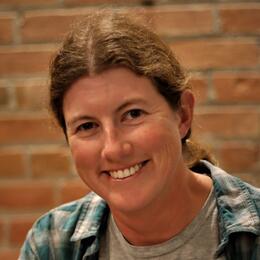Another entry in Abby’s Birdbrained Summer. Abby, the summer communication intern for the Coast Office of Audubon North Carolina, is visiting sites with Audubon’s field staff and our community of volunteers. After she goes into the field, she’ll post blogs detailing her experiences.
I woke up early to meet Zach, Audubon’s Mason Inlet bio tech. He monitors the nests on the north-end of Wrightsville Beach every Monday, Wednesday and Friday. We ducked under the string barricade and Zach gestured in a different direction from the footprints from his past check. “I try to do a different route each day,” he said. He hopes that walking different paths will confuse the birds. They don’t like him because he encroaches upon their territory. He changed hats the morning I went out with him because the other was “covered in bird feces.”
Quiet in nesting area was a bad sign for Least Tern productivity. Unfortunately, a fox has been annihilating most of the nests in the colony. We found a cavernous den in a dune adjacent to the Least Tern colony. Little fox tracks zigzagged from nest to nest, and we found a few broken eggs. Zach pulled up several popsicle sticks that formerly marked viable nests, but now were just empty indentations in the sand. Looking around the area, Zach sighed. “It’s the best habitat, most desolate, fewest people, but the least birds,” he said. Despite the ideal location, predators like the fox have made colonies near Mason Inlet unsuccessful this year.
Rounding a corner, we saw figures standing within the posting, but realized that they were volunteers for the Wrightsville Beach Sea Turtle Project. A turtle went all the way up the beach to lay her eggs on a dune, continued down the far side, and turned around to get back to the ocean. Her path was literally two inches from a Least Tern nest; it seemed like she very consciously avoided the path of the bird eggs.
We walked into the marsh area exposed by low tide and saw five oystercatchers congregating. This behavior was unusual; the birds are normally territorial. Zach hypothesized that the birds were not scaring each other away because their nests had already failed a few times. They get dejected and give up after re-nests fail. Among exposed oyster shells, we saw an egret majestically surveying the scenery and a loon diving for fish.
We stood outside the posting with a scope to approach beach-goers and view the birds. It was low tide, and cormorants and a brown pelican relaxed on a shoal. Several couples walked by and gave us curious looks. “It’s the best conversation starter,” Zach said, referring to the scope. If you happen to see him while you’re on Wrightsville Beach, feel free to ask questions. Zach loves talking about the birds in his nesting colony.
The sun had warmed up, so I was sticky with sweat when we left Mason Inlet. It was discouraging to see how many nests had failed. Nature is harsh, but the birds have adapted for centuries. They will continue even if one colony is hit hard. Hopefully the fox will relocate, and the nests will be more prolific the next time I visit Mason Inlet.




